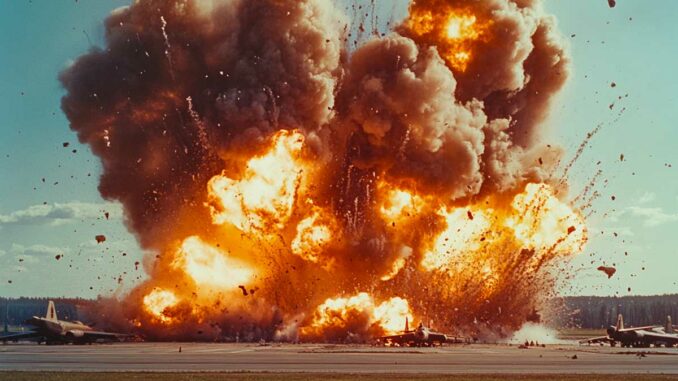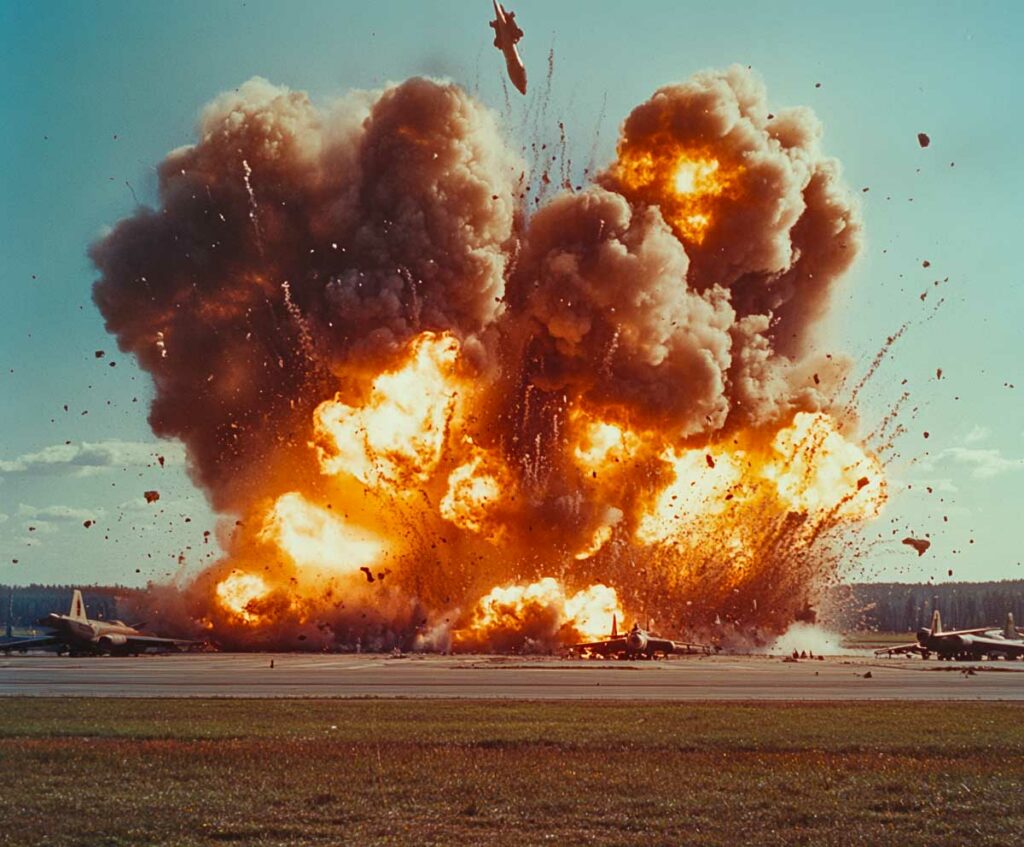
On June 1, 2025, Ukraine carried out an unprecedented drone attack, destroying 34% of Russia’s strategic bombers and inflicting $7 billion in losses.
On June 1, 2025, Ukraine launched Operation Spiderweb, a coordinated drone attack on five Russian air bases, some located more than 4,000 km from the front line. Using 117 FPV drones concealed in modified trucks, the operation destroyed or damaged 41 Russian aircraft, including Tu-95 and Tu-22M3 strategic bombers and A-50 surveillance aircraft. The attack, which represents approximately 34% of Russia’s cruise missile bomber fleet, inflicted an estimated $7 billion in losses. It underscores Ukraine’s ability to conduct complex operations deep inside Russian territory, while highlighting the vulnerabilities of Russia’s air defense.
A drone operation on an unprecedented scale
On June 1, 2025, Ukraine carried out a coordinated drone attack, dubbed “Spiderweb,” targeting five Russian air bases: Belaya (Irkutsk), Olenya (Murmansk), Dyagilevo (Ryazan), Ivanovo, and Ukrainka (Amur). These bases, located up to 4,000 km from the front line, housed Russian strategic bombers.
The operation mobilized 117 FPV (First-Person View) drones, which were smuggled into Russia and concealed in trucks equipped with retractable roofs. Once positioned near the bases, the drones were launched remotely, enabling a surprise attack. This tactic allowed the Russian electronic warfare systems to be circumvented and reduced the reaction time of the air defenses.
The main targets included Tu-95 and Tu-22M3 bombers, as well as A-50 surveillance aircraft. The attack resulted in the destruction or damage of 41 aircraft, representing approximately 34% of Russia’s cruise missile bomber fleet. Losses are estimated at $7 billion.
Impact on Russian strategic capability
Tu-95 and Tu-22M3 bombers are key elements of Russia’s long-range strike capability. The Tu-95, in service since the 1950s, is capable of carrying nuclear cruise missiles. The Tu-22M3, meanwhile, is a supersonic bomber designed for deep penetration missions.
The loss of 34% of these aircraft significantly limits Russia’s ability to carry out strategic strikes. In addition, the production of new bombers is hampered by international sanctions and industrial difficulties. For example, Russia has not produced any new Tu-95s since the 1990s, and the modernization of the Tu-22M3 faces technical and logistical challenges.
The A-50 surveillance aircraft, also targeted, play a crucial role in detecting and coordinating air operations. Their loss reduces Russia’s ability to monitor airspace and coordinate its forces.
Implications for Russian military strategy
The June 1 attack highlighted the vulnerabilities of Russia’s air defense, even deep within its territory. It forces Russia to redeploy its air defense systems to cover a larger area, thereby diluting their effectiveness.
In addition, the loss of long-range strike capabilities could force Russia to change its military strategy, focusing more on ground operations or using less sophisticated means. This could also affect Russia’s deterrence posture toward NATO and its neighbors.
Finally, the attack could prompt Russia to strengthen its internal defense capabilities and invest more in drone detection and interception technologies.

Implications for peace negotiations
The attack comes on the eve of peace talks scheduled to take place in Istanbul. Ukraine has stated that the operation was intended to weaken Russia’s ability to continue the war, while demonstrating its determination to defend its territory.
However, this show of force could complicate negotiations by hardening the positions of both sides. Russia could perceive the attack as an escalation, while Ukraine could be encouraged to maintain a firm stance.
Nevertheless, the attack also highlights Ukraine’s ability to carry out complex, long-range operations, which could strengthen its position in negotiations.
Internal reactions in Russia
The attack has sparked criticism within Russia, particularly from military bloggers and politicians. Some have denounced the inefficiency of the Russian security services and the vulnerability of military installations.
Calls have been made to strengthen the defense of air bases and improve threat detection. Some have also questioned Russia’s overall military strategy and its handling of the war in Ukraine.
This internal criticism could put pressure on the Russian government to review its strategy and strengthen its internal defense capabilities.
Outlook for Ukraine
Operation Spiderweb demonstrates Ukraine’s ability to conduct complex, long-range operations despite limited resources. It also highlights the importance of technological innovation and strategic planning in modern warfare.
However, Ukraine continues to face significant challenges, particularly in the area of air defense. It has expressed the need to acquire more defense systems, such as Patriot batteries, to protect its infrastructure and population.
Finally, this operation could strengthen international support for Ukraine by highlighting its ability to resist and inflict significant losses on its adversary.
War Wings Daily is an independant magazine.